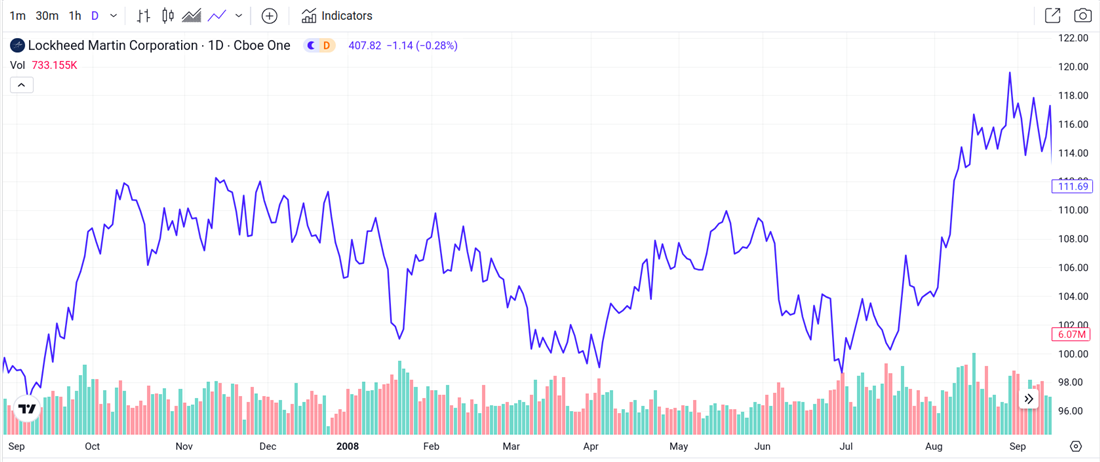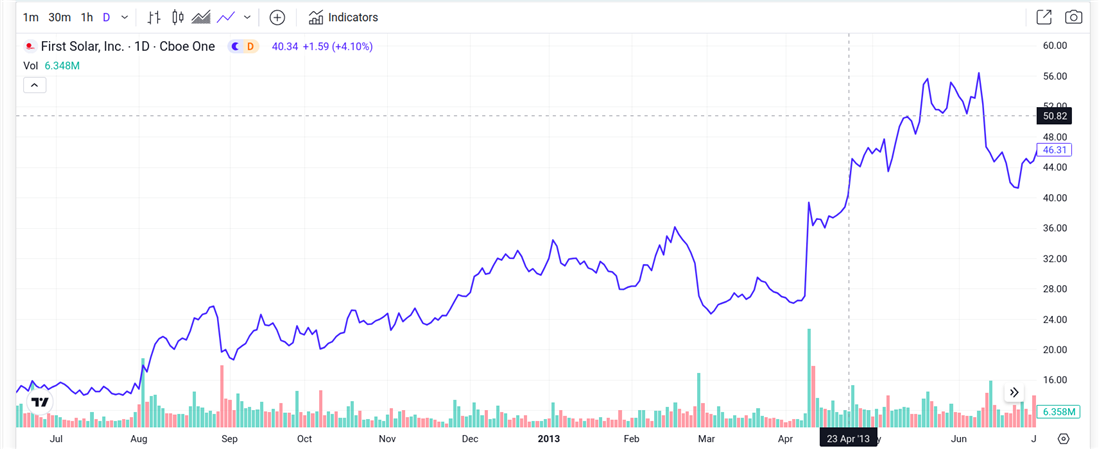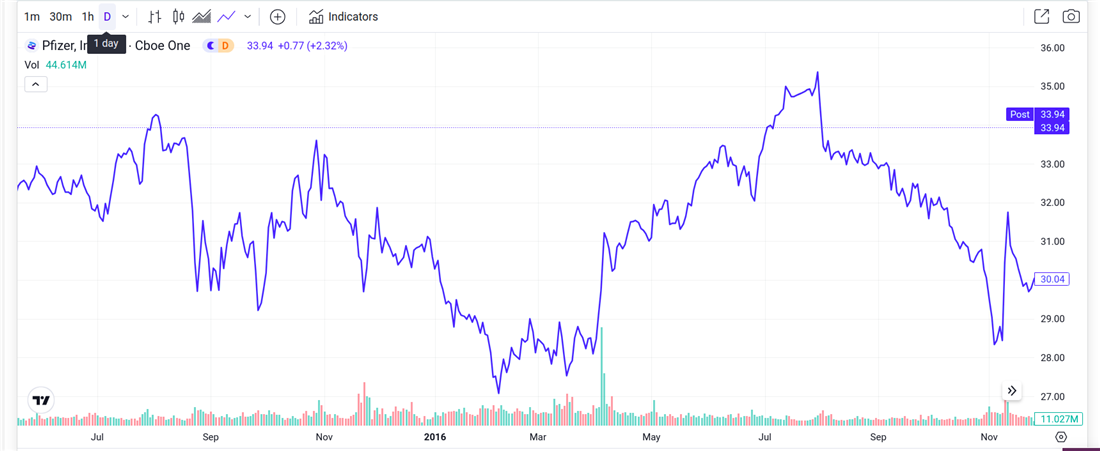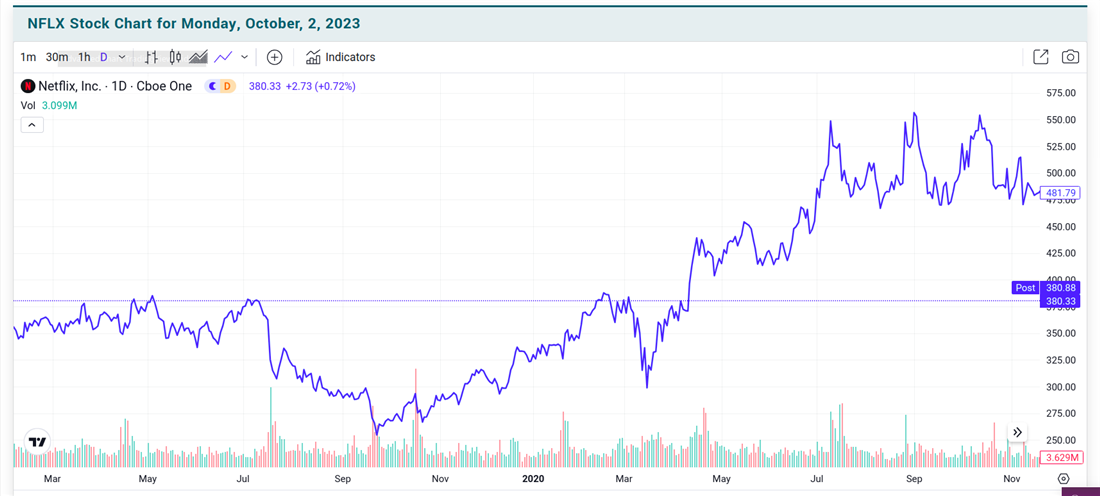Find out which stocks stand to benefit or falter from election cycles. This table currently includes stocks with the largest price changes since the November 2020 election. Learn more.

Key Points
- Elections significantly influence the stock market due to potential policy changes and shifts in leadership, leading to market volatility and opportunities for investors.
- Certain sectors are susceptible to election outcomes and policy changes, making them important for investors to monitor during election years.
- To navigate election-related volatility, you can adopt several strategies.
- 5 stocks we like better than Altair Engineering
When politics and finance cross, it often ripples in the financial world. Elections stand out as significant events with the potential to influence stock market performance. The stock market after election cycles can be volatile and unpredictable. Investors, economists and financial experts diligently research to answer the question, “How will the election affect the stock market”?
Let’s dig into the historical patterns and trends of the stock market in election cycles. We will review the stock market behavior during election cycles, exploring the four-year presidential cycle stock market data and the stock market during midterm elections.
We will also review the implications that election years in the future might hold for the stock market. This examination sheds light on the complex interplay between political decisions and financial markets, equipping you with valuable insights for making well-informed investment decisions.
Introduction to Election Stocks
Elections profoundly impact the stock market, creating a dynamic environment where political decisions can significantly influence financial outcomes. Election years are often marked by increased market volatility as investors react to the uncertainty surrounding potential policy changes and shifts in leadership.
Whether it's a presidential, midterm or local election, the stock market responds to the evolving political landscape. Investors must be prepared for fluctuations and assess how specific election outcomes might affect their portfolios. Let’s look at the intricate relationship between elections and the stock market, shedding light on how election cycles, presidential dynamics and historical trends intersect with investment strategies.
The Influence of Elections on the Stock Market
Elections are pivotal in shaping the stock market's performance and behavior. The impact of elections can be observed across various types of elections, each contributing to unique dynamics within the financial landscape.
Presidential Elections
Presidential elections are perhaps the most closely watched and analyzed events in finance. The stock market's response to presidential elections often results in heightened volatility and anticipation. Investors keenly observe the candidates' economic policies, as they can have far-reaching consequences on industries, sectors and overall market sentiment.
During presidential election cycles, stock market performance is closely scrutinized. Investors weigh the potential impact of a new administration on taxes, regulation, trade policies and fiscal stimulus. As a result, election years often witness market fluctuations as investors adjust their portfolios in anticipation of policy changes. Depending on the prevailing sentiment, the outcome of a presidential election can lead to bullish or bearish trends on both the New York Stock Exchange (NYSE) and the Nasdaq.
Midterm Elections
Midterm elections, occurring halfway through a president's term, introduce a different dimension to the stock market's behavior. These elections primarily impact the composition of Congress, including the House of Representatives and the Senate. While not as attention-grabbing as presidential elections, midterms are nonetheless significant for investors.
Midterm election years have historically been associated with market corrections and increased volatility. The stock market performance after midterm elections tends to respond to shifts in political power.
With potential implications for taxes, healthcare and regulation policies, the stock market after midterms can be volatile. Investors need to navigate this period of uncertainty, strategizing to safeguard their portfolios and capitalize on opportunities that arise during market fluctuations.
Local and Special Elections
Beyond the national stage, local and special elections also influence the stock market, albeit on a smaller scale. These elections can directly impact regional economies, businesses and sectors. For instance, the outcome of a gubernatorial election can influence state-level policies, affecting industries like healthcare, education and energy.
Special elections, often triggered by unexpected events, introduce an element of unpredictability to the stock market. The results of these elections can lead to rapid market responses, particularly when they involve closely contested seats that could sway the balance of power in legislative bodies.
Elections hold a significant sway over the stock market, manifesting their influence in different ways across various types of elections. Whether it's the grand stage of presidential elections, the midway evaluation of midterms, or the microcosm of local and special elections, investors must remain vigilant, adapt to changing political landscapes and implement well-informed investment strategies to navigate the dynamic relationship between elections and the stock market.
Election Cycles and Market Behavior
Stock market election cycles introduce distinct phases, each characterized by unique dynamics and responses. Understanding these phases, particularly the pre-election and post-election periods, is crucial if you are seeking to navigate the market's fluctuations and capitalize on potential opportunities.
Pre-Election Period
The pre-election period is marked by anticipation and heightened volatility in the stock market. Leading up to an election, investors closely monitor candidates' economic policies, campaign promises and potential impacts on the business environment. This scrutiny often translates into market fluctuations as investors adjust their portfolios in response to changing expectations.
Key Factors During the Pre-Election Period
Take a look at several stock factors during the pre-election period:
- Policy speculation: Investors engage in policy speculation, assessing the potential consequences of different candidates assuming office. Policies related to taxes, regulations, trade and fiscal stimulus can significantly influence market sentiment.
- Market volatility: Anticipation of policy changes and uncertainty surrounding election outcomes can lead to increased market volatility. Traders may adopt a cautious approach, leading to short-term fluctuations.
- Sector rotation: Investors may strategically shift their investments between sectors based on which industries are expected to benefit or face challenges under different candidates' administrations.
- Risk assessment: Risk assessment becomes paramount during the pre-election period. Investors evaluate their risk tolerance and diversification strategies in light of potential market turbulence.
- Historical trends: Examining historical stock market performance during past elections can provide insights into potential patterns and reactions, although past performance does not indicate future results.
Post-Election Period
The post-election period witnesses the market's immediate response to the election outcome and the subsequent implementation of policies by the elected officials. This phase can bring both opportunities and challenges, depending on the alignment of policies with market expectations.
Key Factors During the Post-Election Period
In the post-election period, key factors include:
- Market reaction: The stock market often experiences rapid movements following the election results. Investors react to the clarity of leadership and the anticipated policy direction.
- Policy implementation: The effectiveness and policy implementation speed impact market sectors in various ways. Sectors that stand to benefit from new policies may experience growth, while others may face headwinds.
- Economic conditions: Broader economic conditions, such as GDP growth, unemployment rates and inflation, influence post-election market performance. These factors can either bolster or temper market optimism.
- Investment strategy adjustments: Investors assess their portfolios in light of the election outcome and may make strategic adjustments based on the prevailing political landscape.
- Long-term planning: The post-election period encourages long-term planning. Investors and businesses consider how policies and legislation may shape the economy over the coming years.
Election cycles introduce distinctive phases in the stock market, with the pre-election period characterized by anticipation and volatility. In contrast, the post-election period witnesses the market's response to the election outcome and the subsequent policy landscape. Successful navigation of these phases requires diligent analysis, risk management and adaptability to evolving market conditions.
Sectors to Watch During Elections
Election years usher in unique challenges and opportunities for investors, with various sectors responding differently to political shifts and policy changes. Understanding which industries to monitor during elections is essential for making informed investment decisions. Let’s review the key sectors that warrant close attention and dig into the reasons behind their significance in election-driven market dynamics.
Defense Sector: Strategic Investments Amidst Defense Spending
The defense sector emerges as a focal point during election years, primarily due to the heightened emphasis on national security and defense spending. Regardless of political affiliation, administrations often prioritize bolstering the nation's defense capabilities, leading to increased allocations in this sector. Consequently, companies specializing in defense-related products and services stand to benefit from such policy shifts.
Healthcare Sector: Policy-Driven Swings
The healthcare sector is perennially in the spotlight during elections, as proposed changes to healthcare policies can exert significant influence. Alterations to programs like Medicare and Medicaid can impact healthcare stocks, making it crucial for investors to monitor election-related policy proposals closely. This sector's performance can vary widely based on the direction of policy changes.
Energy Sector: Policy-Driven Swings
Energy policies, including environmental regulations and decisions regarding oil and gas drilling permits, are pivotal drivers of the energy sector's performance during election years. Shifts in government priorities and ecological concerns can lead to fluctuations in energy stocks. Investors eyeing this sector should remain vigilant about potential policy adjustments impacting energy-related businesses.
Financial Sector: Taxation and Regulation Matters
The financial sector's fate often intertwines with proposed tax policies and regulations changes. Alterations in taxation rates and financial oversight can profoundly affect the performance of financial stocks. Thus, investors keen on this sector should consider election-related policy shifts and their potential ramifications.
Technology Sector: Antitrust and Intellectual Property Dynamics
The technology sector is not immune to the impacts of elections, particularly concerning changes to antitrust laws and intellectual property rights. Policy adjustments in these areas can have far-reaching consequences for technology stocks. Investors with interests in technology should keep a watchful eye on potential policy shifts.
Consumer Discretionary, Industrials and Materials Sectors: Election-Driven Factors
Beyond the sectors mentioned above, election-driven factors can also influence the performance of consumer discretionary, industrial and materials sectors. These industries often respond to changes in government spending, infrastructure development and consumer sentiment, all of which fluctuate during election cycles.
Investors must carefully navigate the sector impacts of elections, considering the potential policy shifts that can significantly affect their portfolios. A diversified and well-balanced investment strategy remains prudent, allowing investors to weather the volatility accompanying election-related events.
Investment Strategies for Election Stocks
Investing in the election stock market requires a thoughtful and strategic approach, considering the potential market fluctuations associated with political transitions. Let’s look at several different investment strategies tailored for election cycles. These strategies help you navigate the stock market's uncertainties during elections.
Diversification
Diversification is a fundamental strategy that spreads investments across different asset classes, sectors and industries. During election years, diversifying your portfolio can help mitigate risks associated with specific sectors that may be more volatile due to election-related factors. By holding a mix of assets, you reduce the impact of potential market swings resulting from election outcomes.
Long-Term vs. Short-Term Strategies
Long-term investment strategies are advisable if you have a long-term horizon and prefer stability. Such strategies focus on identifying well-established companies with strong track records, solid fundamentals and the ability to weather short-term market volatility. These companies are less likely to be significantly affected by election-related events.
Short-term strategies, such as momentum trading, cater to investors seeking quick profits from market trends and election-driven fluctuations. However, it's crucial to recognize the higher risk associated with short-term trading and the need for vigilant monitoring of market movements.
Sector Focus Based on Election Outcomes
If a Democratic win is likely, consider overweighting sectors such as technology, healthcare, consumer discretionary, utilities and renewable energy. Democratic policies tend to emphasize healthcare reform and environmental sustainability, potentially benefiting companies in these sectors.
In the case of a Republican triumph, focus on sectors like banks, energy, defense and corporate high-yield bonds. Republican administrations often favor deregulation and pro-business policies, influencing these sectors positively.
Options Trading
Options give investors the right, but not the obligation, to buy or sell a stock at a predetermined price within a specified time frame. During election years, options trading can strategically capitalize on short-term market volatility without committing to long-term investments. It allows you to profit from price fluctuations from election-related news and events.
Regardless of your chosen strategy, staying informed about proposed policy changes by the incoming administration is essential. The stock market's reaction to specific policies can vary, making it crucial to adjust your investment positions accordingly.
As the market landscape evolves, regularly rebalance your portfolio to align with your investment goals and risk tolerance. Rebalancing ensures you maintain exposure to sectors and asset classes you believe are best positioned for success, even in election-related uncertainties.
Historical Examples and Case Studies
Examining historical case studies provides valuable insights into how individual stocks have reacted to election outcomes and policy changes over the years. These examples help illustrate the impact of elections on specific companies, with each instance offering a unique perspective. It's important to remember that the influence of elections on stocks can vary based on a range of factors, including the proposed and implemented policies.
Lockheed Martin Corp. (NYSE: LMT)
Following the 2008 presidential election, which resulted in the inauguration of Barack Obama, several significant geopolitical and defense-related factors came into play. One key concern was the heightened tensions with Iran from various international issues. The United States was also recovering from the Iraq War, which had substantially strained its military resources. These circumstances fueled interest in defense spending and the military sector.
During this period, the incoming administration's approach to foreign policy and defense strategy fascinated investors. The anticipation of potential shifts in defense priorities and budgets based on the new administration's policies significantly impacted defense industry stocks like Lockheed Martin.
In the wake of the 2008 presidential election, Lockheed Martin (NYSE: LMT), a prominent defense contractor, experienced notable stock performance. LMT's stock price exhibited a remarkable upward trajectory, surging by more than 20% within the first year following the election. This performance surpassed the overall market's returns during the same period.

Reviewing Lockheed Martin’s price chart, you can see the surge in Lockheed Martin's stock price. This presidential cycle stock market chart shows changes primarily attributed to the expectations of increased defense spending. This increased spending was a response to the geopolitical tensions and the need to bolster military capabilities post-Iraq War. Investors recognized the potential growth opportunities within the defense sector under the new administration, leading to heightened interest in Lockheed Martin and similar defense-related companies.
This case study exemplifies how election outcomes and the associated policy expectations can substantially impact individual stocks, particularly in sectors directly influenced by government policies and geopolitical considerations. It underscores the significance of monitoring election-related developments and policy shifts when making investment decisions, especially in sectors sensitive to political changes and global events.
First Solar Inc. (NASDAQ: FSLR)
The re-election of President Barack Obama occurred in 2012, and his administration was known for its commitment to renewable energy and environmental sustainability. During his first term, President Obama implemented various policies and initiatives to promote clean energy sources, reduce greenhouse gas emissions and foster the growth of the renewable energy sector.
After the election, stock market sectors related to the renewable energy industry, particularly the solar energy sector, garnered significant attention and interest from investors and policymakers.

One of the key features of President Obama's energy policy was his support for renewable energy technologies, which included solar power. His administration introduced various incentives, tax credits and initiatives to stimulate the adoption and development of solar energy projects across the United States. This policy direction created a favorable environment for solar energy companies like First Solar.
First Solar (NASDAQ: FSLR), a prominent player in the solar energy industry, experienced a substantial surge in its stock performance following President Obama's 2012 re-election. Reviewing First Solar’s stock chart reveals that the company's stock price soared more than 50% during this period, significantly outperforming the broader stock market.
The increase in First Solar's stock price was largely attributed to the positive sentiment surrounding the renewable energy sector under President Obama's continued leadership. Investors saw the President's re-election as a validation of his support for renewable energy, particularly solar power. This perception and expectations of continued government incentives and policies favoring the industry led to increased investment interest in First Solar.
The case of First Solar is an example of how political leadership and government policies can substantially influence specific sectors of the stock market. It underscores the importance of monitoring political developments and policy directions when assessing investment opportunities in sectors sensitive to government decisions and regulatory changes.
Pfizer Inc. (NYSE: PFE)
The 2016 U.S. presidential election was notable for Donald Trump's victory, who ran on a platform that included promises to lower drug prices and reform the pharmaceutical industry. Throughout his campaign, President Trump repeatedly criticized the pharmaceutical sector for what he perceived as high drug prices and vowed to address this issue. This stance raised significant concerns within the pharmaceutical industry regarding potential regulatory changes and pricing pressures.
Pharmaceutical companies like Pfizer (NYSE: PFE), one of the industry's largest and most prominent players, faced uncertainty and anxiety due to the incoming administration's intentions regarding drug pricing policies. Investors and industry stakeholders closely monitored the developments and statements from the new administration to gauge the potential impact on pharmaceutical stocks.
In the year following the 2016 presidential election, Pfizer encountered challenges and experienced underperformance compared to the broader stock market. Reviewing Pfizer’s price chart shows that the company's stock price declined by more than 10% during this period, signaling a decline in shareholder value.

Pfizer's stock performance declined partly due to the heightened concerns and uncertainties surrounding the pharmaceutical industry under the new administration. President Trump's commitment to lowering drug prices and implementing pharmaceutical industry reforms cast a shadow of uncertainty over the sector. Investors feared potential regulatory changes that could impact the pricing and profitability of pharmaceutical companies.
The decline in Pfizer's stock price reflects the apprehension and risk aversion within specific industries when there is a perception of increased government intervention and regulatory scrutiny. In this case, the pharmaceutical industry, including Pfizer, faced headwinds due to the policy direction signaled by the incoming administration.
This example underscores the significance of political factors and government policies in influencing the performance of individual stocks, especially in sectors directly impacted by legislative and regulatory decisions. For investors, staying informed about political developments and their potential consequences for specific industries is crucial for making informed investment decisions.
Netflix Inc. (NASDAQ: NFLX)
The 2020 U.S. presidential election marked the election of Joe Biden to the highest office in the nation. During his campaign and following his election, concerns emerged within the technology sector, particularly among companies like Netflix (NASDAQ: NFLX). These concerns were rooted in expectations of increased regulatory oversight and potential policy changes targeting the tech industry.
As President Biden took office, his administration signaled a heightened focus on addressing various aspects of the technology sector, including concerns related to antitrust issues, data privacy and content regulation. These policy intentions raised uncertainties among investors and industry stakeholders about the potential impacts on technology companies.
In the year following President Biden's election victory in 2020, Netflix's stock performance declined, significantly underperforming the broader stock market. Reviewing Netflix’s price chart reveals that the stock price fell by over 20% during this period, indicating a substantial decrease in shareholder value.
 Netflix's stock decline can be attributed to the apprehension and concerns surrounding the potential consequences of increased regulatory scrutiny and policy changes affecting the technology and streaming content industry. Investors closely monitored the policy developments and statements from the new administration as they sought to assess the potential risks and challenges faced by tech companies like Netflix.
Netflix's stock decline can be attributed to the apprehension and concerns surrounding the potential consequences of increased regulatory scrutiny and policy changes affecting the technology and streaming content industry. Investors closely monitored the policy developments and statements from the new administration as they sought to assess the potential risks and challenges faced by tech companies like Netflix.
The decline in Netflix's stock price underscores the vulnerability of technology companies to government policies and regulatory changes. In this case, concerns about increased regulation and the impact on the streaming content and tech industry contributed to declining investor confidence and stock performance.
For investors, this example highlights the importance of considering the regulatory environment and government policy agendas when making investment decisions, especially when investing in sectors susceptible to regulatory changes and government intervention. Staying informed about political developments and their potential consequences for specific industries is essential for prudent investment strategies.
Mitigating Risks and Managing Election-Related Volatility
Investing in the stock market during election cycles can be fraught with uncertainties and fluctuations. To safeguard your investments and navigate the potential volatility associated with elections, consider the following strategies:
- Diversify: Diversification involves spreading your investments across various asset classes, sectors and industries. This strategy reduces the risk of heavy losses in any investment and helps mitigate election-related market turbulence.
- Stay informed: Stay updated on election-related news and developments, especially policies and proposals that may impact the stock market. Informed decision-making is essential for adjusting your investment strategy as the political landscape evolves.
- Embrace a long-term approach: Studies indicate that long-term investors fare better than those who attempt to time the market based on election outcomes. Focus on your financial objectives and adhere to a disciplined investment strategy, minimizing the impact of short-term market fluctuations.
- Prepare for market volatility: Recognize that market volatility is normal in investing. Expect fluctuations during election periods and implement risk management tools such as stop-loss orders to protect your investments from sudden downturns.
- Consider diverse asset classes: Explore investments beyond traditional stocks and bonds. Assets like real estate, commodities and alternative investments can provide additional diversification and mitigate election-related risks.
- Review and adjust your portfolio: Periodically assess your portfolio's performance and ensure it remains aligned with your long-term goals. Adjust your asset allocation and investments if needed to respond to changing market conditions.
- Maintain cash reserves: Keep a portion of your portfolio in cash or cash equivalents. Cash reserves provide the liquidity and the flexibility to capitalize on investment opportunities that may arise during market downturns.
- Utilize options and hedging strategies: Options allow you to protect your portfolio or profit from market volatility without committing to long-term investments. Consider hedging strategies to offset potential losses in one asset class with investments expected to perform well under specific market conditions.
- Avoid impulsive decisions: Avoid making hasty investment decisions based solely on short-term market fluctuations. Patience and a long-term perspective can help you weather election-related storms more effectively.
Navigating the Intersection of Politics and Finance
Election years create a dynamic interplay between politics and finance, significantly impacting the stock market. This multifaceted relationship requires investors to adapt and strategize carefully.
Mitigating risks during election-related volatility involves diversification, long-term strategies, staying informed and seeking professional guidance. Diverse asset classes, portfolio reviews, cash reserves and options and hedging strategies all play a role in managing these risks.
Successful investing during election cycles hinges on patience, adaptability and a well-considered approach. By embracing these principles and staying alert to political changes, investors can navigate the complex intersection of politics and finance, making informed decisions for financial success.
